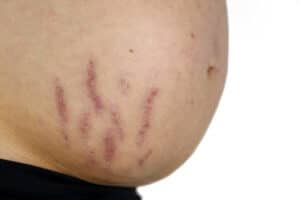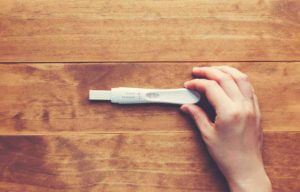For a long time, a cerclage was considered an effective means of counteracting premature births and miscarriages. The term cerclage comes from the French. Literally, it means to surround or wrap around. This means that the gynecologist narrows the cervix of the pregnant woman with a band during this procedure.
Learn everything about the surgical procedure here.
Table of contents
Cerclage: What Is It?
In some cases, the doctor even closes the cervix completely during a cerclage. These surgical procedures are performed under general anesthesia. Alternatively, a more gentle spinal anesthesia, a so-called PDA, is also possible.
A cerclage is used in women who, from painful experience, are at risk of ending their pregnancy too early. The operation is intended to prevent the cervix from opening too early towards the end of the pregnancy, thereby simultaneously widening the cervix.
Instead, the pregnancy should be prolonged until the expected delivery date, if possible. In the 1970s, a cerclage was still considered a cure-all. Accordingly, it was often used.
However, such an intervention is ineffective if the causes of premature labor and premature birth are not eliminated in the woman at the same time. Today, this is one of the reasons why this method is no longer used so often. Because a cerclage is not without danger.
For example, germs can settle in the vagina during the procedure. If labor starts early despite the cerclage, and if it is not possible to stop it quickly, things can get dicey for the expectant mother. This is always the case if the cerclage cannot be reopened quickly.
Cerclage In The Case Of Impaired Closure Of The Cervix
If the cervix of a pregnant woman does not close completely, this can have nasty consequences. The softening and shortening of the cervix (lat.: cervix) that occurs in this case is often completely painless.
This means that neither the pregnant woman nor her attending physician feels the approaching danger. Unnoticed by the expectant mother, it quickly leads to a premature birth or a late miscarriage, the so-called late abortion.
In order to prevent this danger, doctors in the past very often dared to perform a very specific surgical procedure, a cerclage. Even today, the cerclage is preferred by gynecologists when there is no other chance to help the pregnant woman.
Until a few years ago, cerclage was considered the procedure of choice. In this procedure, the gynecologist wraps a band around the cervix and pulls it closed like a cloth bag. This keeps the cervix closed and prevents it from opening prematurely.
Why The Cervix Sometimes Does Not Close Completely
In gynecology, insufficient closure of the cervix (neck of the womb) during pregnancy is called cervical insufficiency.
There are many different reasons for impaired closure of the cervix. They cannot always be fully identified. But if the cervix does not close, it is usually due to:
- Genetically determined changes in the connective tissue.
- Hormonal changes in the cervix.
- Infections.
There are different procedures for closing the cervix by cerclage itself. They are used depending on the findings:
Prophylactic Cerclage
In this case, the gynecologist plays it safe. As a precaution, he closes the cervix at a very early stage of pregnancy. This is because the operation is performed as early as the 13th to the 16th week of pregnancy on patients who have already suffered more than three miscarriages.
Urgent Cerclage
Doctors use this procedure for women whose cervix is shortened. It is then reduced from the anatomically normal 40-50 mm width to slightly less than 25 mm width, i.e. not completely closed.
Emergency Cerclage
This procedure is performed in emergencies. It is used, for example, when the cervix has opened prematurely or when there is a so-called prolapse of the amniotic sac. In this case, the amniotic sac is otherwise in danger of rupturing.
In recent years, the majority of physicians have changed their attitude towards prophylactic cerclage from scratch. As a preventive measure, the procedure is now rather controversial. Many gynecologists are increasingly refusing to simply close the cervix in a pregnant woman as a precautionary measure.
Instead, they recommend that the pregnant woman be closely monitored to prevent the undesirable consequences of an early opening of the cervix.
Is An Open Cervix Dangerous?
Of course, a slightly open cervix at an early stage of pregnancy is not a trifle. However, such cervical weakness is not such a rare occurrence. This slight defect occurs in a number of women.
Most often, it occurs between the fourth and fifth months of pregnancy. Why the cervix opens so early is not even medically detectable in the vast majority of cases. There are of course exceptions, for example, if it is known that the woman in question suffers from a weakness of the connective tissue, for example for genetic reasons.
A slightly open cervix at the beginning of the second trimester can of course be dangerous for the pregnant woman and her child. This can lead to germs settling in the vagina. If this is not counteracted consistently, it can also lead to premature birth, premature labor, and miscarriage.
Take care! If you are not yet in preterm labor, consistent care of your body can help you in such a case. In this way, you can prevent a premature birth at an early stage of your pregnancy. In addition, you must do everything possible to avoid infections in the vaginal area.
With the help and guidance of your doctor or midwife, make sure that the pH level there is kept in an acidic range. You can get test gloves and test sticks for this at any pharmacy. You have to stop already existing infections with great care.
Shortened Cervix – What Does That Mean?
If the cervix is shortened, the inner cervix has already opened in the form of a funnel. The expert calls this funneling. In most cases, a shortened cervix is a sure sign that the first contractions will start soon.
Therefore, depending on the stage of pregnancy and on the week of pregnancy, there is a risk of premature birth. The gynecologist can accurately assess the situation. This is because with the help of ultrasound he can measure the length of the cervix almost to the millimeter.
If the cervix is more than 2.5 cm long, it is usually still okay. However, if the measurement is less than these 2.5 centimeters, check-ups should be performed at short intervals. Strict rest is also indicated. If necessary, the doctor will also prescribe a drug that inhibits labor.
Cerclage – The Chances Of Success
Although a cerclage is no longer performed so often in women today: The procedure has definitely helped many patients. A number of serious studies have shown that a cerclage has prolonged the duration of pregnancy in women from the risk group.
For example, a study at the University of Munich found that therapeutic cerclage could prolong pregnancy by an average of about 70 days. In many cases, these spans are vital for the child.
Cerclage also reduced the number of premature births and miscarriages in a number of women with pre-existing conditions. However, in this case, the cerclage was part of a whole package of measures to support the expectant mother. A cerclage alone is therefore by no means a guarantee that the child will be born safely.
How The Doctor Performs A Cerclage
Closure of the cervix in a pregnant woman can be performed in two different ways. Experts distinguish between cerclage using the McDonald method and cerclage using the Shirodkar method. McDonald’s method is called the bloodless method, while Shirodkar’s method is called the bloody method.
Method According To McDonald
In this type of cerclage, a so-called tobacco bag suture is placed. Using a thread that does not dissolve (non-absorbable), the surgeon sutures counterclockwise around the cervix. The suture is then united and tightened. The ends are cut long, which facilitates their removal later.
Shirodka Method
In this type of cerclage, the surgeon places the suture under the vaginal skin covering the cervix. To do this, he splits it over a length of two to three centimeters. Here, too, a non-absorbable thread is used. The ends of the threads are also left long and disinfected.
What Happens After The Operation
A cerclage only makes sense if the patient receives optimal medical and nursing care after the operation. Special attention is paid to these measures around the cerclage:
- The condition of the pregnancy is closely monitored.
- Inflammation levels are checked regularly.
- The area around the cervix is inspected as a preventive measure.
- Antibiotics as anti-inflammatories are used.
- If necessary, the doctor gives agents that inhibit labor.
The cerclage is released after the 37th week of gestation.












